
|
Special Effects (F/X) - Milestones in Film 2003-2005 |
 
|
The Matrix Reloaded (2003) and The Matrix Revolutions (2003) The two sequels to The Matrix (1999) were these two sci-fi action films, from the writer-director team of The Wachowski Brothers. The Matrix Reloaded introduced high-definition 'Universal Capture' (or U-cap) or image-based facial animation into the special effects lexicon, used in the so-called "Burly Brawl" sequence, between Neo (Keanu Reeves) and 100 Agent Smiths (Hugo Weaving). Five high-resolution digital cameras recorded the real Agent Smith's actions to produce data which was fed into a computer, where a complex algorithm calculated the actor's appearance from every single angle the cameras had missed, and used them to generate digital or 'cloned' humans indistinguishable from real humans.
The Matrix Reloaded also featured one of the most thrilling freeway car chases in film history, using as little CGI as possible, and relying mostly instead on physical effects for the crashes (hidden ramps and cannons), although Agent Smith was added in post-production. The Matrix Revolutions featured the first realistic, very close-up representation of detailed facial deformation on a synthetic human, during a face punch. This scene occurred during the final climactic fight between Agent Smith (Hugo Weaving) and Neo (Keanu Reeves), when Smith was punched in the face. |
 Multiple Agent Smiths in the "Burly Brawl" Sequence 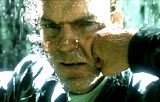   Face Punch |
|||||||||||||||

|
Pirates
of the Caribbean: The Curse of the Black Pearl (2003) It was nominated for the Academy Award for Best Visual Effects for only a fairly short segment of F/X, and lost the Oscar (with Master and Commander: The Far Side of the World (2003)) to Peter Jackson's third trilogy film, The Lord of the Rings: The Return of the King (2003). However, CGI effects (from ILM) were used to startling effect in the film's final sequence to seamlessly turn the cursed Black Pearl pirates, led by Captain Hector Barbossa (Geoffrey Rush) - when first revealed - from normal humans to ghoulish, anatomically-detailed living skeletons ("The moonlight shows us for what we really are"). In the film's conclusion during a moonlit night, the 'undead' pirates snuck up on the British Royal Navy and the HMS Dauntless by walking across the ocean floor in skeleton form, and then crawling up the ropes on the sides of the ship undetected. |
   
|
|||||||||||||||

|
Able Edwards (2004) Director Graham Robertson's futuristic sci-fi film echoed many of the attributes of the classic Orson Welles' Citizen Kane (1941), while attaining a big-budget feel without spending a lot of money. The entire feature, in reality a desktop-computer cinematic creation, was made in 15 days with a budget of only $30,000. As in Kane, it began with a death, and then newsreel footage about the deceased title character (spelled Abel), a famous entertainment mogul who started out as a political cartoonist at the Denver Post, and eventually ran a Hollywood studio and a theme-park resort in San Pedro, California. The reason it was so inexpensive was that it was the first publicly-released feature film shot entirely without physical sets (they were computer-generated and produced solely with CGI). Real actors were then shot with a mini-DV against the green screen set backgrounds. |
  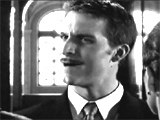
|
|||||||||||||||
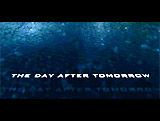
|
The Day After Tomorrow (2004) This apocalyptic, big-budget, global-warming disaster film from Roland Emmerich about a global catastrophe was a box-office success and praised for its visual effects, although it was criticized for some scientific inaccuracies (mostly for compressing so many extreme catastrophes into such a short time frame). It was very unlikely that the Northern Hemisphere was about to be plunged into a new Ice Age. However, the film was tasked with representing the effects of global warming and climate change -- flooding, tornadoes, tidal waves, snow and ice, and even wolves (real wolves were only used as models for digital doubles). It used a variety of F/X techniques including matte paintings, 3D graphics, and miniatures. There were some astounding special effects, including realistic-looking encroaching frost, snow and ice, and the seamless use of digital extras (in crowd scenes) and set extensions (to include cars, helicopters, tents, and other structures).
The MTV Movie Awards honored "The Destruction of Los Angeles" sequence as the Best Action Sequence of the year. The disaster film used 50,000 scanned photos of a 13 block area of NYC to create a 3D photo-realistic model of the city. The model (a digital backdrop) of the downtown metropolis was destroyed by a giant digital tsunami wave and afterwards was frozen over. The film also featured one of the longest-ever CG flyover shots under the opening titles. It was a three minute fly-over of the Larsen B Antarctica ice shelf - a 4,000 frame shot. At the time, it was one of the longest continuous, all-digital shots in a live-action film in film history. In the next few minutes, the shelf ominously cracked, endangered a research crew, sent frigid water into the Gulf Stream, and the massive climate shift quickly triggered an Ice Age.
Controversy over global warming (and possibly phony claims) was again stirred up when Al Gore used the same digital fly-over footage (without the credits) for An Inconvenient Truth (2006) - some called Gore's film a "blatant fraud," "propagandistic," and "entirely dishonest" for using CG footage to exaggerate environmental concerns. |
    NYC Tsunami 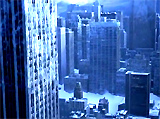 Super-Freezing of NYC  Opening CGI Fly-Over |
|||||||||||||||

|
Immortal (Ad Vitam) (2004, Fr./It./UK) (aka Immortel (Ad Vitam)) Like Able Edwards (2004), Sky Captain and the World of Tomorrow (2004), Casshern (2004), and Sin City (2005), this sci film set in the year 2095 seamlessly blended live actors with computer-generated surroundings. Director Enki Bilal's film was loosely based upon his own comic book La Foire Aux Immortels (The Carnival of Immortals). This imaginative, highly-visual and creatively-designed live-action and animated hybrid was one of the first films to use an entirely "digital backlot" (i.e. all of the actors were shot in front of blue- and green-screens with all the backgrounds added in post-production). The film went one step further also. It featured live actors interacting with semi photo-realistic CGI "humans." There was a cold, bleak and bluish-gray tint to the entire film, but it provided beautifully-designed cityscapes. One of the more striking images was of the ancient Egyptian god Horus, "a naked guy with a bird's head" - who emerged from a giant pyramid floating above the city of New York. The falcon-headed Horus had only seven days before being executed. He was looking for a human host body to inhabit and searching for a mate for procreation (to carry on his line), but was challenged because the genetically-altered humans would self-destruct during mating. An evil corporate entity known as Eugenics had synthetically altered most human beings. Horus was able to incorporate himself into the only human who had not undergone genetic alteration (due to criminal incarceration cryo-sleep), ex-con and fugitive Alcide Nikopol (Thomas Kretschmann). Inhabiting Nikopol's body, Horus came upon a rare and beautiful white-skinned, blue-scaled genetic mutant named Jill Bioskop (Linda Hardy) with blue hair and tears. She was mysterious because she had no memory of who she was, appeared to be only three months old, and her internal organs had a unique rearrangement - fascinating to doctor Elma Turner (Charlotte Rampling). |
 Egyptian Gods Bast and Anubus (entirely CGI)  Horus (also CGI)  Jill Bioskop  
|
|||||||||||||||

|
The Incredibles (2004) This computer-animated feature film by writer/director Brad Bird was Pixar's sixth one, with a story about a family of superheroes. There were a total of 2,200 shots in the film, many of which required special effects features. It was the first of Pixar's films to feature human characters for the main roles, such as Bob and Helen Parr (alias Mr. Incredible and Elastigirl), among others. CG films had always experienced difficulty animating human characters with subtle movements or expressions (rippling or flexing muscles, flipping or bouncing hair, and puckering or stretching skin). The animators had to choreograph the characters' complex movements and expressions through specially-programmed computer controls. To help the digital animators and production crew to create more realistic humans, they were presented with live-action footage of people flexing, walking, and moving. Pixar was required to create new software to animate detailed parts of the human anatomy, including clothing and realistic skin and hair. For the muscle-bound main character Bob, a new technology was developed called 'goo,' which allowed the skin to react to the muscles sliding and sticking underneath it in a very realistic way. For the depiction of clothing, more than 150 garments were specially designed and tailored to fit the lead and background characters. The most challenging character was Helen Parr, aka Elastigirl, who had to be able to stretch, bend, and fold into a vast array of shapes. A program called "deformer" allowed her to twist and turn into multiple positions or poses. For the creation of realistic-looking skin and hair, Pixar came up with a new technology called "subsurface scattering," which gave more translucency to the skin and made the characters seem more alive. Violet's long flowing hair presented the most problems for animators. The problem was solved by creating five different sculpted hairstyles for the different phases of the film. Additional challenges included creating natural-looking fire, water, ice, air, smoke, steam, clouds and explosions. |
    
|
|||||||||||||||
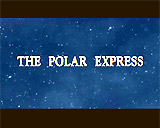
|
The Polar Express (2004) This Robert Zemeckis-directed film was based upon Chris Van Allsburg's popular picture book of the same name. It told the story of a mysterious black train that took a young boy on a journey to the North Pole on Christmas Eve. It further developed live-action 'motion capture' technology found in the pioneering Peter Jackson film The Lord of the Rings: The Two Towers (2002). The animated film was budgeted at a record-breaking $165 million. It was IMAX's first full-length, animated 3-D feature. It was the first CGI film that used 'motion capture' to create every character, although it was criticized as having lifeless, clone-looking human characters. Zemeckis' film was marked by the first innovative use of the process of 'Performance Capture' -- a motion capture system by which an actor's live performances were digitally captured by computerized cameras, and became a human blueprint for creating virtual, all-digital characters. Unlike existing motion-capture systems, Performance Capture simultaneously recorded 3-dimensional facial and body movements from multiple actors, using a system of digital cameras that provided 360 degree views. This allowed actor Tom Hanks to play many very different digital characters (the Hero-boy, the Father, the Conductor, the Hobo, Scrooge, and Santa Claus) in the same film. [Note: Zemeckis went even further with his 'motion-capture' techniques in his film Beowulf (2007).] |
  
|
|||||||||||||||

|
Sky Captain and the World
of Tomorrow (2004)
It was the first big-budget movie with very photo-realistic, all-CGI backgrounds and live actors. [Note: See also Able Edwards (2004), Immortal (Ad Vitam) (2004), and Sin City (2005) - all 'digital backlot' films produced around the same time.] About 100 digital artists, modelers, animators and compositors created multi-layered 2D and 3D backgrounds, to be later combined with the live action footage. Human actors were completely filmed in front of a green/blue screen on sound stages with no background sets at all. Everything - except the main characters - was computer-generated.
[Note: The film also used actor Laurence Olivier, post-humously, after his death date of 1989. It used archived BBC footage of the actor and inserted it into the film with digital effects.] |
  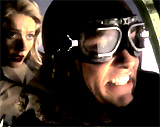 
|
|||||||||||||||

|
The improved special digital FX budget for this superior blockbuster sequel totaled approximately $54 million. The film was a remarkable achievement in terms of the quantity of visual effects shots (almost 600 computer generated (CG) shots), and it ultimately set a new standard for CG human characters. The main villain that Peter Parker/Spider-Man (Tobey Maguire) battled was Doctor Otto Octavius ("Doc Ock") (Alfred Molina), a brilliant and prestigous nuclear scientist who became Peter's idol. Doctor Octavius was experimenting with fusion technology to provide the world with a perpetual source of energy. After a disastrous malfunction and fusion accident that resulted in the loss of his wife, four large, indestructible metal tentacles that were attached to Octavius' waist and spine became permanently wired to him. The super-strong tentacles (with mini-claw hands) seemed to have a diabolical, malevolent mind of their own, although Octavius could mentally control them. The tentacles also had cameras (to aid his vision) and allowed him to climb walls and walk on any kind of surface. Special effects software was developed to recreate downtown Manhattan, simulate shattering glass, flying debris, the breaking of pavement and buildings, etc. Many of the key action scenes involved the use of very convincing, realistic-looking computer-generated stunt doubles. It was very challenging to match the live actors with their digital counterparts, especially the seamless integration of facial expressions and costuming. Special effects software 'motion captured' the faces of the live actors – Maguire and Molina - and then matched them up to the computer-generated characters. There were a number of spectacular scenes involving struggles between web-slinging Spider-Man (suffering in part with an identity crisis) and the insane Doc Ock:
In the conclusion, Octavius decided to repeat his fusion experiment, but it went out of control and became unstable. Octavius chose to drown his nuclear reactor and himself ("I will not die a monster!") to avoid a doomsday scenario for New York City. This required extensive CGI, live action, and model work. |
    Villain Doc Ock 
|
|||||||||||||||

|
King Kong (2005) Peter Jackson's remake of the classic and tragic beauty-and-the-beast love story in the 1933 film featured a computer-generated Kong (with some doubles for interactive scenes), and a virtual NYC set. The 3 hour action-adventure film, with a record-breaking $207 million budget, was remarkable for having the largest number of special/visual effects shots in a single film, surpassing the previous records set by Star Wars, Episode III: Revenge of the Sith (2005), and Jackson's own trilogy of The Lord of the Rings films.
The remake repeated the story about filmmaker Carl Denham (Jack Black) who hired vaudeville performer Ann Darrow (Naomi Watts) to join him on a journey to Skull Island, where she was kidnapped by natives and was about to be sacrificed to the giant 25-foot ape King Kong, a silverback gorilla. The beast was a 3-D model, created with both motion capture and digital animation. The computer processing power of about 15,000 PCs was used to create and integrate the giant gorilla into live-action footage, during post-production. New fur simulation software and new fur shaders had to be created in order to properly animate Kong's five million hairs. The more than 3,200 final shots in the film were culled from 3 million feet of live-action footage and 2,510 visual effects shots. Digital doubles were used for scenes where it was too difficult for the actors. And CG was mostly used for all the other deadly creatures, including a stampeding herd of brontosaurs (the worst CGI in the film!), meat-eating raptors, a number of T-Rexs, giant centipedes, crickets, toothy slugs, and giant batlike creatures.
Andy Serkis (who performed the role of the CGI character Gollum in The Lord of the Rings trilogy) provided both on-set performance reference and a motion-capture performance (in a blue body suit with optical markers) for the title character. In preparation for the role, Serkis studied the actual behavior and movement of real silverback gorillas. |
 Ann Touched by Kong  T-Rex  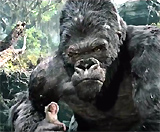 Ann Rescued From T-Rexs by Kong  Kong on the Loose in NYC  Kong on the Top of Empire State Building  Kong's Goodbye |
|||||||||||||||

|
Sin City (2005) Along with a few other films at the time, including Sky Captain and the World of Tomorrow (2004), Casshern (2004), Able Edwards (2004), and Immortal (Ad Vitam) (2004), to be shot primarily on a digital backlot, in high-definition digital. The fully digital, live-action film seamlessly blended live actors (shot in front of a green-screen) with computer-generated artificial surroundings and backgrounds. There were only a few real sets constructed for the film. The neo-noir crime thriller was a stylistic comic book adaptation - mostly viewed in high-contrast black and white and containing some vibrant splashes of color (i.e., for eyes, or clothing, etc.) due to its unique color processing and "visual shaping." The entire film was first shot in color, and then reduced to black and white through digital color-correction techniques. There were a number of recognizable, prominent actors who portrayed the diverse characters in the graphically-violent and bold film:
|
 Hartigan (Bruce Willis)  Nancy (Jessica Alba)  Yellow Bastard (Nick Stahl) 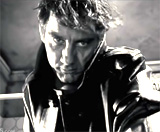 Dwight McCarthy (Clive Owen)  Gail (Rosario Dawson) |
|||||||||||||||
 
|
Wallace & Gromit: The Curse
of the Were-Rabbit (2005, UK) It was produced in partnership with DreamWorks Animation, and was the studio's second win in the Animated Feature Film category (following Shrek (2001)). It marked a few other honors (following Spirited Away (2001, Jp.), the winner in 2002) as:
It became the only stop-motion film to win the Oscar in the category. It featured over 700 examples of digital effects, including CGI effects.
Wallace was a good-natured, cheese-loving, eccentric inventor, while Gromit was Wallace's faithful, mute canine companion. The story was about a town in England named Tottington Hall holding a "giant vegetable competition." The duo - with their new humane pest-relocation service titled "Anti-Pesto," were hired to investigate reports of a mysterious, garden-consuming beast producing "vegetable carnage." They discovered the presence of a mutant were-rabbit. |
 Eccentric Inventor Wallace  Mute Canine Gromit 
|
|||||||||||||||